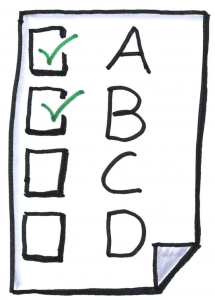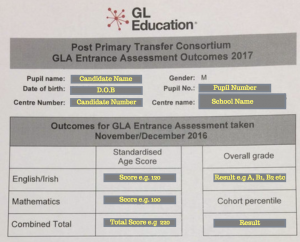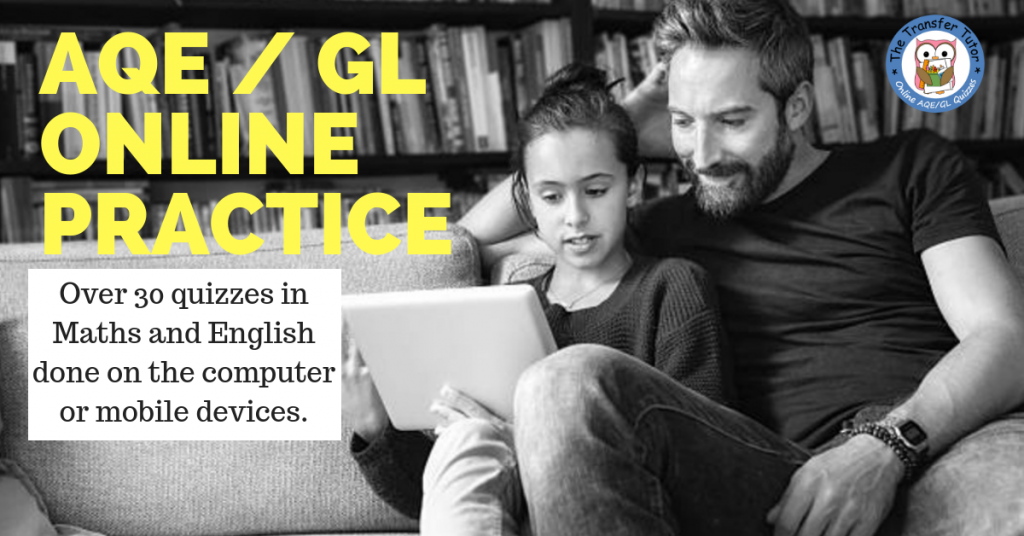Introduction to GL
Originally founded by the National Foundation for Educational Research (NFER), with whom they continue to work today, GL Assessment has been part of the Granada Learning Group since 2000. Renowned for their rigour and high quality, GL Assessment tests are used every year by over 85% of all UK and N. Ireland primary and post primary schools. You may be familiar with your child taking the Progress in English or Progress in Mathematics assessments in primary school which are GL Assessment products. GL Assessment is the largest independent provider of educational assessments in the UK and N. Ireland. With over thirty years of experience in this field, GL Assessment enjoys an established, trusted reputation for high-quality assessment resources and services.
The Actual GL Test in Northern Ireland

The GL Test consists of two papers and the child takes both on the same day.
The first paper, assessing English, will last 50 minutes and the second paper, assessing Mathematics, will last 45 minutes.
Both papers will be in a multiple choice format and the children will record their answers on a separate answer sheet which is then marked to derive the child’s result.
The Results

The picture above shows a sample results sheet and so, let’s break this down and explain the various areas in detail.
PERSONAL INFORMATION
This is given at the top and is simply there to identify the child and confirm their name, date-of-birth, pupil number etc. As well as the parents being reassured that this is indeed the results for their child, this information is necessary when the results are sent off on the post-primary transfer form.
ENGLISH / IRISH STANDARDISED AGE SCORE (top left of outcome table)
This will be between 69 – 141 and it will be the standardised score that the child achieved in the English paper, where 100 is the mean (average).
MATHS STANDARDISED AGE SCORE (middle left of outcome table)
This will be between 69 – 141 and it will be the standardised score that the child achieved in the Maths paper, where 100 is the mean (average).
COMBINED TOTAL (bottom left of outcome table)
This will be between 138 – 282 is simply calculated by adding ‘English / Irish Standardised Score’ + ‘Maths Standardised Score‘.
So, in the picture example above, the child got 120 in English/Irish and 100 in Maths, so therefore they received 220 (120 + 100) in their Combined Total.
But don’t be thinking that your child should be getting anywhere near 282 as this is an absolute maximum is almost impossible!
OVERALL GRADE (top right of outcome table)
Along with the scores, your child will receive an overall grade of A, B1, B2, C1, C2 or D.
The grades will be allocated on the basis of the Combined Total score and to offer an indication, the grade boundaries in 2019 were given as below. However, this was last year’s boundaries and this year’s might be wider.
- Grade A : Combined Total 234+
- Grade B1 : Combined Total 229 – 233
- Grade B2 : Combined Total 224 – 228
- Grade C1 : Combined Total 219 – 223
- Grade C2 : Combined Total 213 – 218
- Grade D : Combined Total 138 – 212
*Please note, it’s not possible to indicate exactly what actual mark is necessary for an ‘A’ for this year or future years because it will all depend on the average score for that paper.
COHORT PERCENTILE (bottom right of outcome table)
Cohort Percentiles range from <30 to 99+ with 50 as the mean.
This Cohort Percentile is also based on the Combined Total score.
This particular element of the results (the Cohort Percentile) often causes some confusion as it’s not a term you’d often hear or even use during the practice tests in school. The best way to describe this is that it’s a bit like percentages but percentages are based on raw marks whereas percentiles are based on standardised marks.
You may be familiar with percentiles when your child’s growth and weight was being recorded and plotted on the growth charts in their little, red books, and you would’ve been informed of their percentile at that time.
So, let’s take some examples in simple terms to try and understand this more:
- If Matthew achieved a cohort percentile of 50, this means that he did better than 50% of the other candidates who took the test.
- If Matthew achieved a cohort percentile of 35, this means that he did better than 35% of the other candidates who took the test.
Age Impact On Standardised Scores

GL explain that an age allowance operates within the scoring of the assessment and they say that it’s one of the reasons why they’ll report the results as Standardised Age Scores on which the grades will be based. No further, detailed information is provided, but GL assure parents that in calculating the Standardised Age Score, the age of the child is taken into account but no child will lose marks because of his/her age.
Requesting A Remark

GL will advise that the latest date for requests for a remark and this would be done via the GL Assessment Centre.
More about The Transfer Tutor (Multi-Award Winning Online Quizzes)
Google Reviews

Check out the Google Reviews to read what other customers felt about The Transfer Tutor.

The Transfer Tutor’s Online Quizzes provide a fun and interactive way to learn and practise Maths and English questions which are directly aligned to both the AQE and GL specifications.
There are many, great features including (but not limited to):
- Quizzes broken down into specific English and Maths topics, to allow for focused learning and the ability to hone in on areas of weakness.
- Mobile friendly and works on any internet device.
- ‘Hint’ option supports the child’s learning. For example, in question about calculating area of an irregular shape, the hint will say, “Break it into two” – enough to keep the child going but teaching them for future, similar questions.
- The Leaderboard at the end makes the child feel like they’re playing a game and having friendly competition.
- Good use of colour and graphics which makes it exciting.
- Parents receives a progress email at the end to let them know how their child did.
How To Buy
Simply choose the licence you need depending on the length of time you need access, click on the blue box, pay and then you’ll be off within minutes.
For any further questions, please contact me or check out the Frequently Asked Questions page.
All of these are a one-off payment until they expire – so no additional costs.

Try It Out:

To give you a feel for the quizzes, why not try out the quick fire free quiz by clicking on the button below (no need to register or pay, so don’t worry). This will hopefully let you see how the questions work – or more importantly, let you see if this is something that would inspire and encourage your child to learn.
Social Media Links – Keeping Up To Date

Follow or like The Transfer Tutor on your social media channel of choice and ensure you never miss a beat with the whole transfer process, handy tips, advice, special offers and competitions.
Click below for your preferred channel or search for @TransferTutorHQ wherever you are.
Free Facebook Group

You may have read in the reviews about people referring to the Facebook Support Group and this is certainly a great place to keep informed, ask questions, get support and keep up-to-date with anything happening in the transfer space.
It’s free to join but please ensure you have a genuine Facebook profile picture (ghost pictures are not approved as not deemed authentic) and then simply click here and answer the simple questions -> Join Facebook Group.
